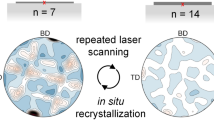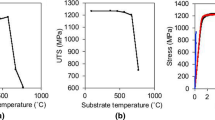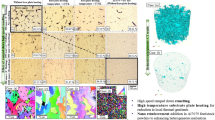Abstract
Components made by laser powder bed fusion (L-PBF) additive processes require extensive trial and error optimization to minimize defects and arrive at targeted microstructure and properties. In this work, in situ infrared thermography and ex situ surface roughness measurements were explored as methodologies to ensure Inconel® 718-part quality. For a given laser energy of 200 Watts, prismatic samples were produced with different exposure times (80 to 110 µs) and point spacings (80 to 110 µm). The infrared intensities from laser–material interaction zones were measured spatially and temporally. The conditions leading to higher IR intensity and lowest surface roughness values correlated well with less porosity and coarse solidification grain structure. The transition from highly columnar to misoriented growth is attributed to changes in thermal gradients and liquid–solid interface velocities. Hardness measurements and electron microscopy of the as-processed and post-processed heat-treated samples show complex transitions in microstructural states including the heavily dislocated FCC matrix, reduction of dislocation density, and copious precipitation, respectively. These results show that the geometry-process-structure-property correlations are dynamic, and they cascade depending on the transitions of phase states from powder to liquid to solid, as well as phase decompositions and deformations within the solid FCC phase. Validity of using analytical weld process models to describe the above phenomena is also highlighted.






















Similar content being viewed by others
References
R. A. Roach and S. H. Gardner, Translational Materials Research, 2017, Vol. 4, 044001
M. Seifi, M. Gorelik, J. Waller, N. Hrabe, N. Shamsaei, S. Daniewicz, and J. J. Lewandowski, JOM, 2017, Vol. 69, pp. 439-455
B. H. Jared, M. A. Aguilo, L. L. Behini, B. L. Boyce, B. W. Clark, A. Cook, B. J. Kaehr, and J. Robbins, Scripta Materialia, 2017, Vol. 135, pp. 141-147
NIST: Measurement Science Roadmap for Metal-based Additive Manufacturing, prepared by Energetics Incorporated, 2013. http://www.nist.gov/el/isd/upload/NISTAdd_Mfg_Report_FINAL-2.pdf.
S.K. Everton, M. Hirsch, P.Stravroulakis, R.K. Leach, and A.T. Clare, Mater. Des. 2016, Vol. 95, pp. 431–445
H. Krauss, C. Eschey, and M.F. Zaeh: Proc. 23rd Annu. Int. Solid Free. Fabr. Symp. 2012, pp. 999–1014, https://doi.org/10.1017/cbo9781107415324.004.
S. Clijsters, T. Craeghs, S. Buls, K. Kempen, and J. P. Kruth., Int. J. Adv. Manuf. Technol. 2014, Vol. 75, pp. 1089–1101
R.B. Dinwiddie, R.R. Dehoff, P.D. Lloyd, L.E. Lowe, and J.B. Ulrich, Thermo-sense Therm. Infrared Appl. Xxxv, 2013, Vol. 8705, pp. 1–9
R.B. Dinwiddie, M.M. Kirka, P.D. Lyod, R.R. Dehoff, L.E. Lowe, G.S. Marlow: Proc. SPIE, 2016, Vol. 9861. https://doi.org/10.1117/12.2229070.
S. Moylan, E. Whitenton, B. Lane, and J. Slotwinski: 40th Annu. Rev. Prog. Quant. Nondestruct. Eval., AIP Conf. Proc. 2014, Vol. 1581, pp. 1191–96. https://doi.org/10.1063/1.4864956.
G. Marshall, W.J. Young II, N. Shamsaei, J. Craig, T. Wakeman, and S.M. Thompson: Proc. Solid State Free Form. 2015, pp. 259–72. https://sffsymposium.engr.utexas.edu/sites/default/files/2015/2015-21-Marshall.pdf.
E. Rodriguez, J. Mireles, C. Terrazas, D. Espalin, M. Perez, and R.B. Wicker, Additive Manufacturing., 2015, Vol. 5, pp. 31–39, https://doi.org/10.1016/j.addma.2014.12.001
M. Doubenskaia, M. Pavlov, S. Grigoriev, and I. Smurov, Surf. Coatings Technol., 2013, Vol. 220, pp. 244–247, https://doi.org/10.1016/j.surfcoat.2012.10.044
G. Bi, A. Gasser, K. Wissenbach, A. Drenker, and R. Poprawe, Opt. Lasers Eng., 2006, Vol. 44, pp. 1348–1359, https://doi.org/10.1016/j.optlaseng.2006.01.009
P. Lott, H. Schleifenbaum, W. Meiners, K. Wissenbacj, C. Hinke and J. Bultmann, Physics Procedia, 2011, Vol. 12, pp. 683-690
W. S. Land II, B. Zhang, J. Ziegert and A. Davies, Procedia Manufacturing, 2015, Vol. 1, pp. 393-403
S. Huber, J. Glasschroeder and M. F. Zaeh, Physics Procedia, 2011, Vol. 12, pp. 712-719
L. Mrna and M. Sarbort, Physics Procedia, 2014, Vol. 56, pp. 1261-1267
M. Schwalbe: Predicting theoretical and computational approaches for additive manufacturing. Proc. Workshop Natl. Acad. Sci., 2016
ISO/ASTM 52900:2015(E): Standard terminology for additive manufacturing – General principles – Terminology, ASTM International, 2016
I. Yadroitsev, A. Gusarov, I. Yadroitdave, I. Smurov, J. Mater. Process. Technol., 2010, Vol. 210, pp. 1624-1631
I. Yadroitsev and I. Smurov, Physics Procedia, 2010, Vol. 5, pp. 551-560
S. Tammas-Williams, H. Zhao, F. Leonard, F. Derguti, I. Todd, and P.B. Prangnell, Materials Characterization, 2015, Vopl. 102, pp. 47-61
W. Sames, F. A. List, S. Pannala, R. R. Dehoff and S. S. Babu, International Materials Reviews, 2016, Vol. 61, pp. 315-360
S.S. Babu: in Introduction to Integrated Weld Modeling. ASM Handbook, D.U. Furrer and S.L. Semiatin, eds., ASM International, 2010, vol. 22B.
S. Yoder, S. Morgan, E. Barnes, C. Kinzy, P. Nandwana, M. Kirka, S. S. Babu, V. Paquit, and R. R. Dehoff, Additive Manufacturing, 2018, Vol. 19, pp. 184-196
A. Plotkowski, M. M. Kirka, and S. S. Babu, Additive Manufacturing, 2017, Vol. 18, pp. 256-268
N. Raghavan, A. Plotkowski, R. R. Dehoff, J. A. Turner, M. K. Kirka, and S. S. Babu, Acta Materialia, 2017, Vol. 140, pp. 375-387
Z. C. Cordero, R. B. Dinwiddie, and R. R. Dehoff, Journal of Materials Science, 2017, Vol. 52, pp. 3429-3435
N. Raghavan, S. S. Babu, R. R. Dehoff, S. Pannala, S. Simunovic, M. K. Kirka, J. Turner and N. Carlson, Acta Materialia, 2016, Vol. 112, pp. 303-314
J. Raplee, A. Plotkowski, M. Kirka, R. Dinwiddie, A. Okello, R. R. Dehoff and S. S. Babu, Sci. Rep. 2017, Vol. 7, 43554; https://doi.org/10.1038/srep43554
I. Yadroitsev and I. Smurov, Physics Procedia, 2011, Vol. 12, pp. 264-270
M. Groeber, E. Schwalbach, W. Musinski, P. Shade, S. Donegan, M. Uchic, D. Sparkman, T. Turner and J. Miller, JOM, 2018, Vol. 70, pp. 441-444
W. Sames, K. Unocic, G. Helmreich; S. S. Babu; R. Dehoff; F. Medina, Additive manufacturing, 2016, Vol. 13, pp. 156-165
W. Sames, K. Unocic, R. R. Dehoff, T. Lolla and S. S. Babu, Journal of Materials Research, 2014, Vol. 29, pp. 1920-1930
Y. Ogawa, Science and Technology of Welding and Joining, 2011, Vol. 16, pp. 33-43
S. Tsukamoto, Science and Technology of Welding and Joining, 2011, Vol. 16, pp. 33-43
R. R. Dehoff, W. J. Sames, M. K. Kirka, H. Bilheux, A. S. Tremsin and S. S. Babu, Materials Science and Technology, 2015, Vol. 31, pp. 931-938
J. Gockel, L. Sheridan, S. P, Barra, N. W. Klingbeil, J. Beuth, JOM, 2017, Vol. 69, pp. 2706-2710
C. R. Clymer, J. Cagan, and J. Beuth, Journal of Mechanical Design, 2017, Vol. 139, 100907
M. Tang, P. C. Pistorious, J. L. Beuth, Additive Manufacturing, 2017, Vol. 14, pp. 39-48
D. Rosenthal, Welding Journal, 1941, Vol. 20, pp. 220-234
P. W. Fuerschbach, Welding Journal, 1996, Vol. 75, pp. 24s-34s
M. J. Aziz, Journal of Applied Physics, 1982, Vol. 53, pp. 1158-1168
S. S. Babu, J. W. Elmer, J. M. Vitek, and S. A. David, Acta Materialia, 2002, Vol. 50, pp. 4763-4781
A. Plotkowski, O. Rios, N. Sridharan, Z. Sims, K. Unocic, R. T. Ott, R. R. Dehoff, and S. S. Babu, Acta Materialia, 2017, Vol. 126, pp. 507-519
J. O. Andersson, T. Helander, L. Hoglund, P. F. Shi and B. Sundman, CALPHAD, 2002, Vol. 26, pp. 273-312
M. Gaumann, C. Bezencon, P. Canalis, and W. Kurz, Acta Materialia, 2001, 49: 1051-1062
M. Y. Krasnoperov, R. R. G. M. Pieters and I. M. Richardson, Science and Technology of Welding and Joining, 2004, Vol. 9, pp. 501-506
S. S. Babu, S. M. Kelly, M. Murugananth, R. P. Martukanitz, Surface Coating and Technology, 2006 Vol. 200, pp. 2663-2671
S. S. Babu, R. P. Martukanitz, K. D. Parks, and S. A. David, Metallurgical and Materials Transactions A, 2002, 33A, 1189-1200
C. Villafuerte, H. W. Kerr, and S. A. David, Materials Science and Engineering A, 1995, Vol. 194, pp.187-191
J. H. Martin, B. D. Yahata, J. M. Hundley, J. A. Mayer, T. A. Schaedler and T. M. Pollock, Nature, 2017, Vol. 549, pp. 365-369
O. M. Barabash, S. S. Babu, J. M. Vitek, S. A. David, J. -W. Park, J. A. Horton, G. E. Ice, and R. I. Barabash, J. App. Physics, 2004, Vol. 96, pp. 3673 – 3679
O. M. Barabash, S. S. Babu, S. A. David, J. M. Vitek and R. I. Barabash, Journal of Applied Physics, 2003, 94, No. 1., 738-742
P. J. Withers and H. K. D. H. Bhadeshia, Materials Science and Technology, 2001, Vol. 17, pp. 366-375
D. Wian, J. Xue, A. X. Zhang, Y. Li, N. Tamura, Z. Song and K. Chen, Scientific Reports, 2017, 7: 2859
Y. M. Wang, T. Voisin, J. T. McKeown, J. Ye, N. P. Calta, Z. Li, Z. Zeng, Y. Zhang, W. Chen, T. T. Roehling, R. T. Ott, M. K. Santala, P. J. Depond, M. J. Matthews, A. V. Hamza and T. Zhu, Nature Materials, 2018, Vol. 17, pp. 63-71
S.S. Babu: in Proc. Int. Conf. Solid–Solid Phase Transform. Inorg. Mater. M. Millitzer, G. Botton, L.-Q. Chen, J. How, C. Sinclair, and H. Zurob (eds.) TMS, 2015, pp. 1019–26
K.T. Makiewicz: MS Thesis, The Ohio State University, 2013
S. Fukumoto and W. Kurz, ISIJ International, 1999, Vol. 39, pp. 1270-1279
J. A. Dantzig and M. Rappaz, “Solidification,” 2nd Edition, EPFL Press, Lausanne, 2016
S. S. Babu, International Materials Reviews, 2009, Vol. 54, pp. 333-367
S. J. Jones and H. K. D. H. Bhadeshia, Acta Materialia, Vol. 45, pp. 2911-2920, 1997
J. W. Christian, “The theory of transformations in metals and alloys v1 and v2,”1st Edition, Pergamon Press, Oxford, 2002
Acknowledgments
The authors of this work would like to acknowledge and thank the funding contributor Applied Optimization, Inc. under the NASA STTR Phase II program (Contract Number: NNX15CA24C). Part of the research is based upon work supported by the US Department of Energy, Office of Energy, Efficiency, and Renewable Energy, Advanced Manufacturing Office under Contract Number DE-AC05-00OR22725. The microscopy was supported by using instrumentation (FEI Talos F200X S/TEM) provided by the Department of Energy, Office of Nuclear Energy, Fuel Cycle R&D Program and the Nuclear Science User Facilities. D.W. Coffey assisted with the experimental work. The United States Government retains and the publisher, by accepting the article for publication, acknowledges that the United States Government retains a non-exclusive, paid-up, irrevocable, world-wide license to publish or reproduce the published form of this manuscript, or allow others to do so, for United States Government purposes. The Department of Energy will provide public access to these results of federally sponsored research in accordance with the DOE Public Access Plan. (http://energy.gov/downloads/doe-public-access-plan).
Author information
Authors and Affiliations
Corresponding author
Additional information
Manuscript submitted May 6, 2018.
Appendices
Appendices
1.1 Appendix A1: Hardware Setup for In Situ Infrared Imaging
The details of our IR imaging experiments, installed within the Renishaw® AM250 machine, are briefly summarized. The geometry of the IR camera placement is shown in Figure A1. A front surface mirror was positioned inside the build chamber to allow for the camera to access the whole field of view available for the AM processing surface. Due to the use of the mirror at a certain angle, we did have keystone distortions in the image. Although, we can correct the images using matrix methods, this was not done to avoid any interpolation effects. The IR camera was equipped with a 25mm germanium lens with a neutral density #2 filter. A 1TB solid-state high-speed data recorder was used in order to take images at high speed for the entire layer collection. Custom-built programs were written using MatLab® and IgorPro® software packages to extract the IR intensity, as well as, to do visualization and statistical analysis.
All the recorded videos for the conditions are provided in the following YouTube location and summarized in Table AI.
1.2 Appendix A2: Analytical Heat Transfer Model
Thermal cycles under steady-state conditions for the E-PBF process were calculated using the following equation, which is indeed a derivative of the classic formulism developed by Rosenthal.[42] This equation was used for estimating the thermal distribution during E-PBF by Sames et al.[24]
In the above equation, T0 is the preheat temperature (443 K), Q is the heat input (200 W), V is the scan velocity, t is the time in seconds, y is the distance perpendicular to the beam direction, z is the distance along the thickness of the powder bed or solid, ao is the thermal diffusivity, t0 is the characteristic time given by the equation (\( r_{\text{b}}^{2} /4a \)), rb is the radius of the heat source (35 µm), and zo is the characteristics thickness given by the equation \( \left(\left[ {\left( {\left( {r_{\text{b}} /e} \right)/\left( {\pi ar_{\text{b}} /V} \right)} \right)^{0.5} } \right]\right) \). The following parameters (Table AII) were used for calculation of thermal distribution shown in the main text. While calculating thermal distribution for the 100 pct powder bed condition (no solid underneath), the powder thermal conductivity was assumed to be 15 pct of the solid nickel.
1.3 Appendix A3: Interface Response Function Model
For the benefit of the reader, the salient equations to describe columnar to equiaxed transition (CET) and relevant thermodynamic data for the alloy 718 are based on the classical interface response function developed by solidification researchers.[61,62] The original governing equation for the CET was derived by Gaumann et al.[48] to describe the probability of stray grains (ϕ), which is given below:I
In the above equation, G is the thermal gradient, ΔTc is the constitutional tip undercooling, n is the power factor, and N0 is the number density of pre-existing nuclei ahead of the liquid–solid interface. In the above equation, the roles of liquid–solid interface velocity (RL/S) and dendrite tip radius (RTip) are taken care of through a change in the ΔTc, given by the following equation:
In the above equation, \( c_{\text{o}}^{i} \) is the nominal concentration of ith element, \( m_{\text{o}}^{i} \) is the equilibrium liquidus slope, \( m_{\text{V}}^{i} \) is the velocity-dependent liquidus slope, \( c_{\text{l}}^{i*} \) is the concentration of the ith element at the dendrite tip, and Γ is the Gibbs–Thomson coefficient. The \( c_{\text{l}}^{i*} \) can be calculated using the following equation:
In the above equation, \( k_{\text{v}}^{i} \) is the partitioning ratio for ith element as a function of liquid–solid interface velocity and Iv{Pe} is the Ivantsov function of the Peclet (Pe) number. The Pe is related to the liquid–solid interface velocity (RL/S), dendrite tip radius (RTip), and the diffusivity (Di) of the ith element in liquid with the following relationship:
Furthermore, the velocity-dependent partitioning (\( k_{\text{v}}^{i} \)) is related to the equilibrium partitioning ratio (\( k_{\text{o}}^{i} \)) and the characteristic diffusion distance (\( a_{0} \)) through the following relationship derived by Aziz[44]:
Similarly, the liquid slope (\( m_{\text{V}}^{i} \)) is given by the following relationship:
The only other unknown in the above formulation is the dendrite tip radius (RTip), which is described by the well-known interface instability criteria given below:
With the above Eqs. [A3] through [A7] and thermodynamic data from CALPHAD techniques,[45,63] it is possible to construct the solidification maps for any alloy composition. The data used for the calculations are summarized in Table AIII.
1.4 Appendix A4: Simultaneous Transformation Kinetics Model
In all the computational weld mechanics modeling or additive manufacturing, it is important to describe the solid-state phase decomposition of the parent phase (γ) to different product phases (γ′ and/or γ″, Laves, MX and δ phase) during repeated heated and cooling in the solid-state. In this regard, the simultaneous transformation kinetics (STK) modeling framework development by Jones and Bhadeshia[64] can be adopted. This model can consider competition between individual precipitates when calculating the nucleation and growth rates based on the assumptions made for JMAK theory,[65] in a discrete fashion. Makiewicz et al.[60] extended this formulism to additive manufacturing of Inconel 718 alloys. Although the details of this theoretical formulism are outlined by Makiewicz et al.,[60] the methodology is briefly described below for context. In order to describe the phase transformations that occur in any arbitrary thermal cycle that involves multiple heating and cooling modes, the whole cycle is subdivided into smaller isothermal steps at a given temperature. The model takes the initial microstructure (e.g., \( v_{\gamma '}^{i} \), volume fraction of phase) at (i − 1)th time step, before entering ith time step (dt) at a given temperature and calculates the change of the fraction depending on the volume fraction of all the other phases.
In the above equation, \( dv_{{\gamma '({\text{ext}})}}^{i} \) is the change in extended volume of the γ′ phase given by the following equation, by assuming spherical precipitates:
In the above equation, Iv is the nucleation rate, \( G_{3}^{*} \) is the growth rate, t is the equivalent time, and τ is the incubation time at that given temperature. The Iv for each phase can be calculated using a generic equation given below:
where \( Q_{\text{act}} = \frac{{16\pi \sigma^{3} }}{{3\Delta G_{\text{v}}^{2} }} \) is the activation energy for nucleation, which is a function of interfacial energy (σ) and the maximum driving force (\( \Delta G_{\text{v}} \)) for nucleation. This driving force can be calculated using ThermoCalc® software.[47] The growth rate of each phase can be calculated using the following equation, which relates the supersaturation and the growth rate \( \left( {G_{3}^{*} } \right) \), assuming no soft impingement. The typical equation for the γ′ is given below:
The supersaturation term in the above equation is related to the bulk concentration of principal element \( \left( {x_{\text{o}} } \right) \) controlling the diffusion-controlled growth of γ′, \( x_{\gamma } \) is the interface concentration at the FCC matrix, and \( x_{\gamma '} \) is the interface concentration of γ. The \( \chi_{\gamma '} \) is the empirical acceleration parameter used to throttle down or up certain precipitates. Makiewicz et al.[60] used experimental data from a laser powder blown deposition process (DED) to calibrate these parameters (see Table AIV). We have adopted the above methodology to rationalize the solid-state decomposition during the Gleeble® thermal simulations. The STK model requires sixteen parameters as inputs, however, the calibrations developed for the DED process underestimated the precipitation volume fractions of γ′ and γ″ with reference to the controlled Gleeble® simulated thermal gyration experiments and, also, published data from EBM builds.[35] To correct these underestimations, a new set of calibration parameters was developed (see Table AIV).
Rights and permissions
About this article
Cite this article
Foster, S.J., Carver, K., Dinwiddie, R.B. et al. Process-Defect-Structure-Property Correlations During Laser Powder Bed Fusion of Alloy 718: Role of In Situ and Ex Situ Characterizations. Metall Mater Trans A 49, 5775–5798 (2018). https://doi.org/10.1007/s11661-018-4870-2
Received:
Published:
Issue Date:
DOI: https://doi.org/10.1007/s11661-018-4870-2





